child seat GMC SAVANA 1998 Owners Manual
[x] Cancel search | Manufacturer: GMC, Model Year: 1998, Model line: SAVANA, Model: GMC SAVANA 1998Pages: 388, PDF Size: 20.04 MB
Page 9 of 388
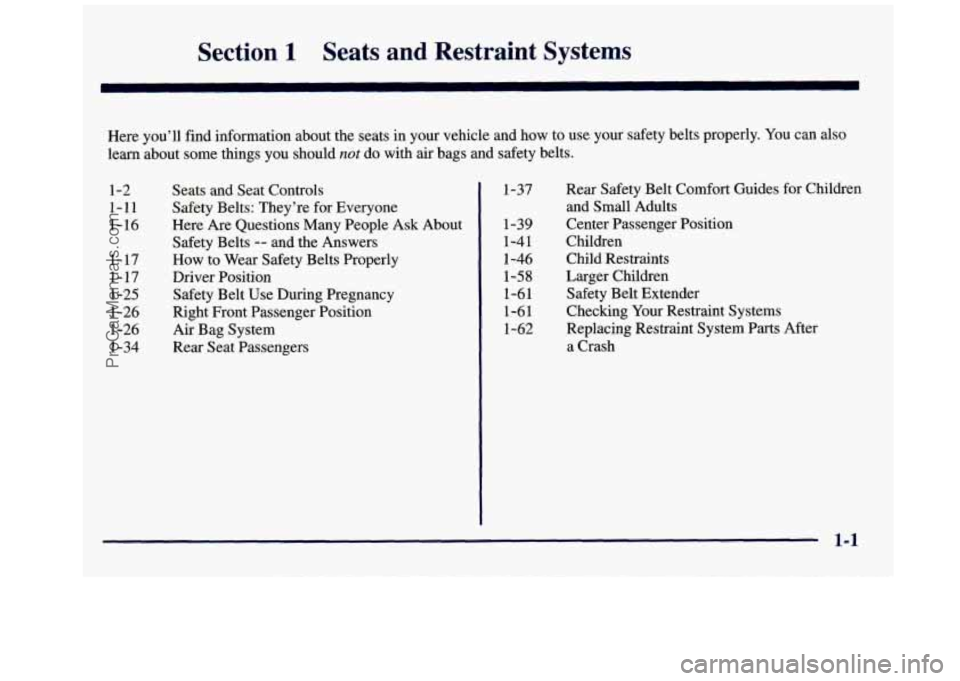
Section 1 Seats and Restraint Systems
Here you’ll find information about the seats in your vehicle\
and how to use your safety belts properly. You can also
learn about some things you should
not do with air bags and safety belts.
1-2 1-11
1-16
1- 17
1-17
1-25
1-26
1-26 1-34 Seats and Seat Controls
Safety Belts: They’re for Everyone
Here Are Questions Many People Ask About Safety Belts
-- and the Answers
How to Wear Safety Belts Properly
Driver Position Safety Belt Use During Pregnancy
Right Front Passenger Position
Air Bag System
Rear Seat Passengers 1-37
1-39
1-41
1-46
1-58 1-61
1-61
1-62 Rear Safety Belt Comfort Guides for Children
and Small Adults
Center Passenger Position
Children Child Restraints
Larger Children
Safety Belt Extender
Checking Your Restraint Systems
Replacing Restraint System Parts After
a Crash
ProCarManuals.com
Page 25 of 388
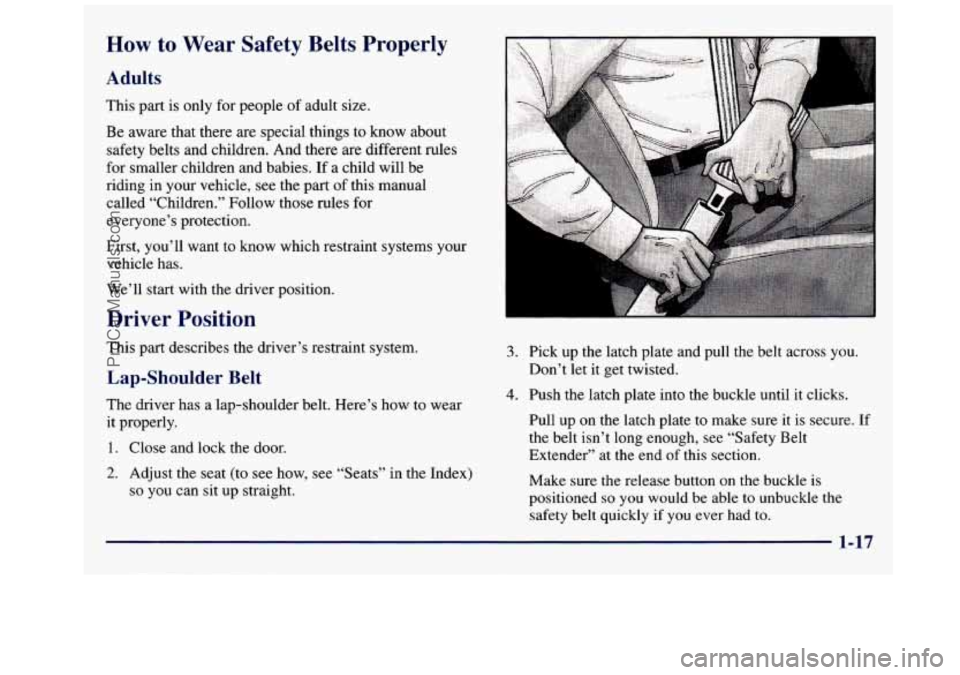
How to Wear Safety Belts Properly
Adults
This part is only for people of adult size.
Be aware that there are special things to know about
safety belts and children. And there
are different rules
for smaller children and babies.
If a child will be
riding in your vehicle, see the part
of this manual
called “Children.” Follow those rules for
everyone’s protection.
First, you’ll want to know which restraint systems your vehicle has.
We’ll start with the driver position.
Driver Position
This part describes the driver’s restraint system.
Lap-Shoulder Belt
The driver has a lap-shoulder belt. Here’s how to wear
it properly.
1. Close and lock the door.
2. Adjust the seat (to see how, see “Seats” in the Index)
so you can sit up straight.
3. Pick up the latch plate and pull the belt across you.
4. Push the latch plate into the buckle until it clicks.
Don’t
let it get twisted.
Pull
up on the latch plate to make sure it is secure. If
the belt isn’t long enough, see “Safety Belt
Extender” at the end
of this section.
Make sure the release button on the buckle is
positioned
so you would be able to unbuckle the
safety belt quickly
if you ever had to.
1-17
ProCarManuals.com
Page 34 of 388
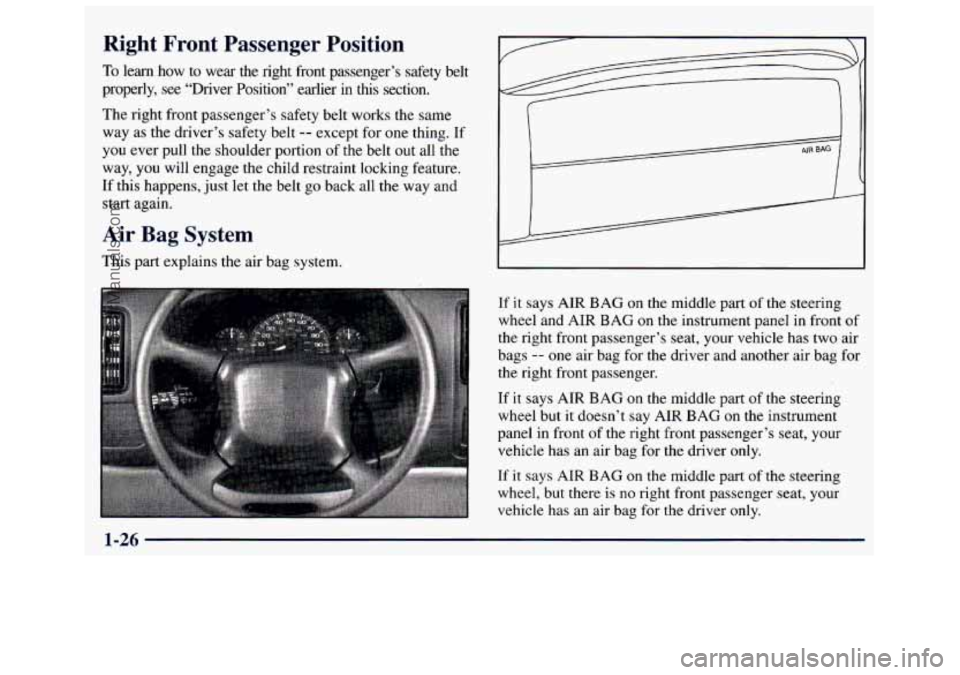
Right Front Passenger Position
To learn how to wear the right front passenger’s safety belt
properly, see “Driver Position” earlier in this section.
The right front passenger’s safety belt works the same
way as the driver’s safety belt
-- except for one thing. If
you ever pull the shoulder portion of the belt out all the
way, you will engage the child restraint locking feature.
If this happens, just let the belt
go back all the way and
start again.
Air Bag System
This part explains the air bag system.
If it says AIR BAG on
the middle part of the steering
wheel and AIR BAG
on the instrument panel in front of
the right front passenger’s seat, your vehicle has two air
bags
-- one air bag for the driver and another air bag for
the right front passenger.
If it says AIR BAG on the middle part of the steering
wheel but it doesn’t say AIR BAG on the instrument
panel in front of the right front passenger’s seat, your
vehicle has an air bag for the driver only.
If
it says AIR BAG on the middle part of the steering
wheel, but there is no right front passenger seat, your
vehicle has an air bag for
the driver only.
1-26
ProCarManuals.com
Page 45 of 388
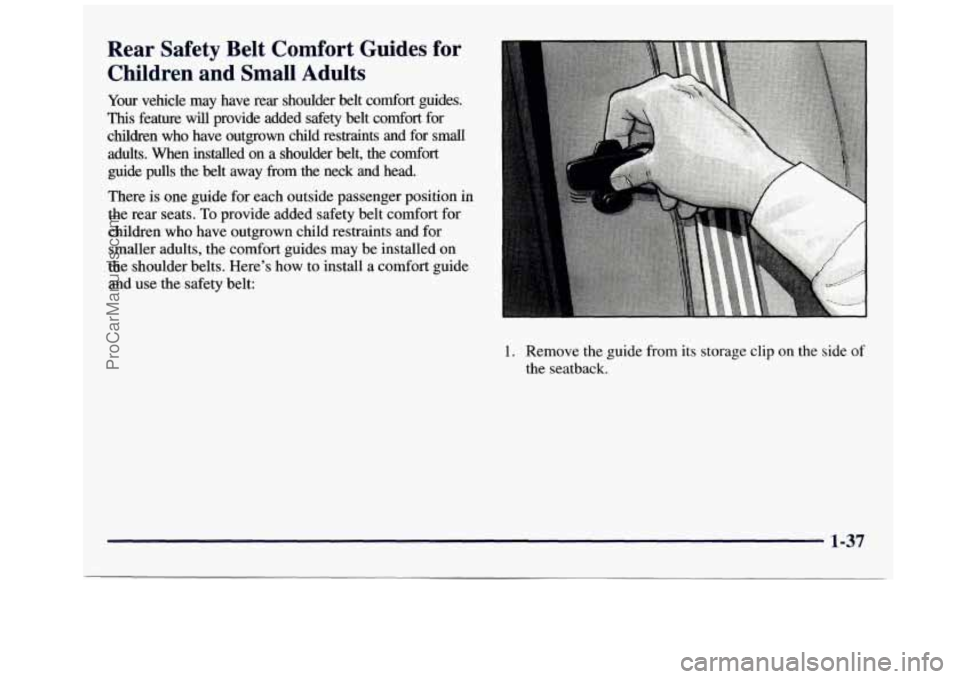
Rear Safety Belt Comfort Guides for Children and Small Adults
Your vehicle may have rear shoulder belt comfort guides.
This feature will provide added safety belt comfort for
children who have outgrown child restraints and for small
adults. When installed
on a shoulder belt, the comfort
guide pulls the belt away
from the neck and head.
There is one guide for each outside passenger position in
the rear seats.
To provide added safety belt comfort for
children who have outgrown child restraints and for
smaller adults, the comfort guides may be installed on
the shoulder belts. Here’s how to install a comfort guide
and use the safety belt:
1. Remove the guide from its storage clip on the side of
the seatback.
1-37
ProCarManuals.com
Page 56 of 388
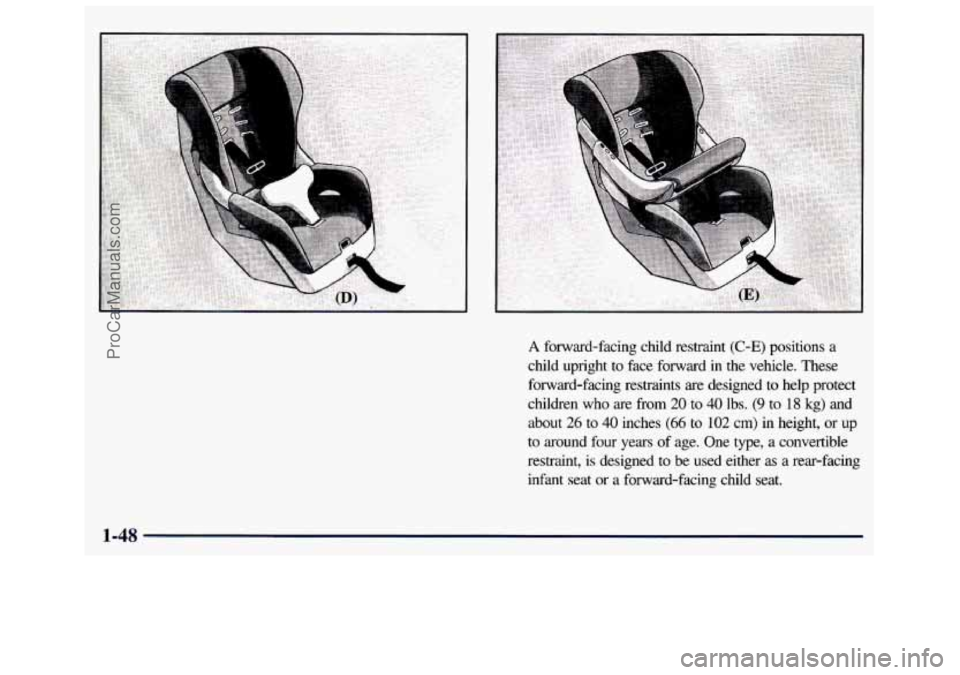
, . ..
A forward-facing child restraint (C-E) positions a
child upright to face forward in the vehicle. These
forward-facing restraints are designed to help protect
children
who are from 20 to 40 lbs. (9 to 18 kg) and
about
26 to 40 inches (66 to 102 cm) in height, or up
to around four years of age. One type, a convertible
restraint,
is designed to be used either as a rear-facing
infant seat or a forward-facing child seat.
1-48
ProCarManuals.com
Page 57 of 388
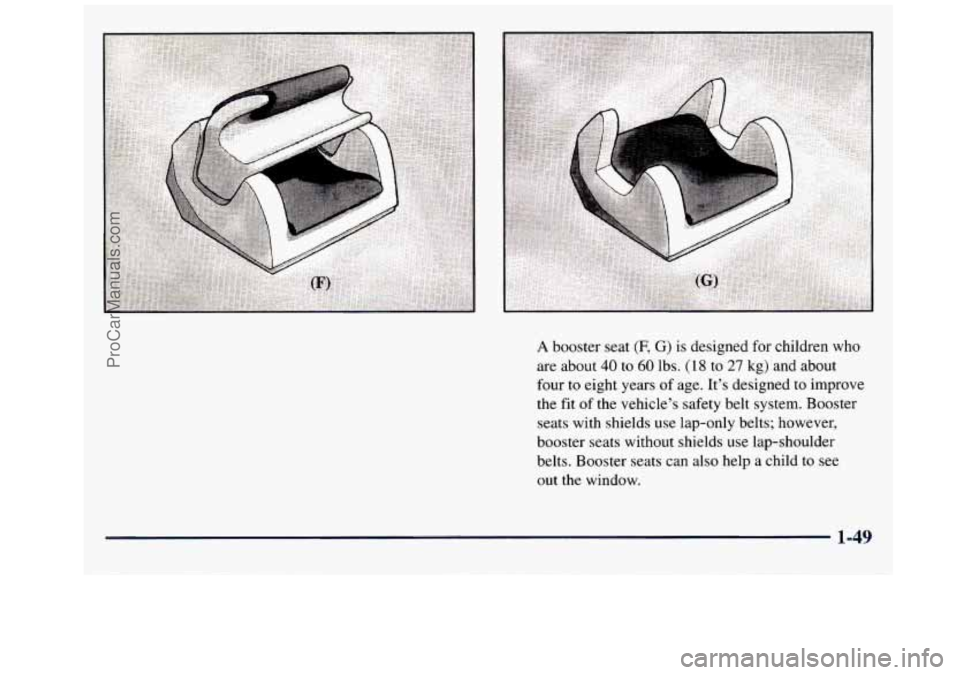
A booster seat (F, G) is designed for children who
are about
40 to 60 lbs. (18 to 27 kg) and about
four to eight years of age. It’s designed to improve
the fit of the vehicle’s safety belt system. Booster
seats with shields use lap-only belts; however,
booster seats without shields use lap-shoulder
belts. Booster seats can
also help a child to see
out the window.
1-49
ProCarManuals.com
Page 58 of 388
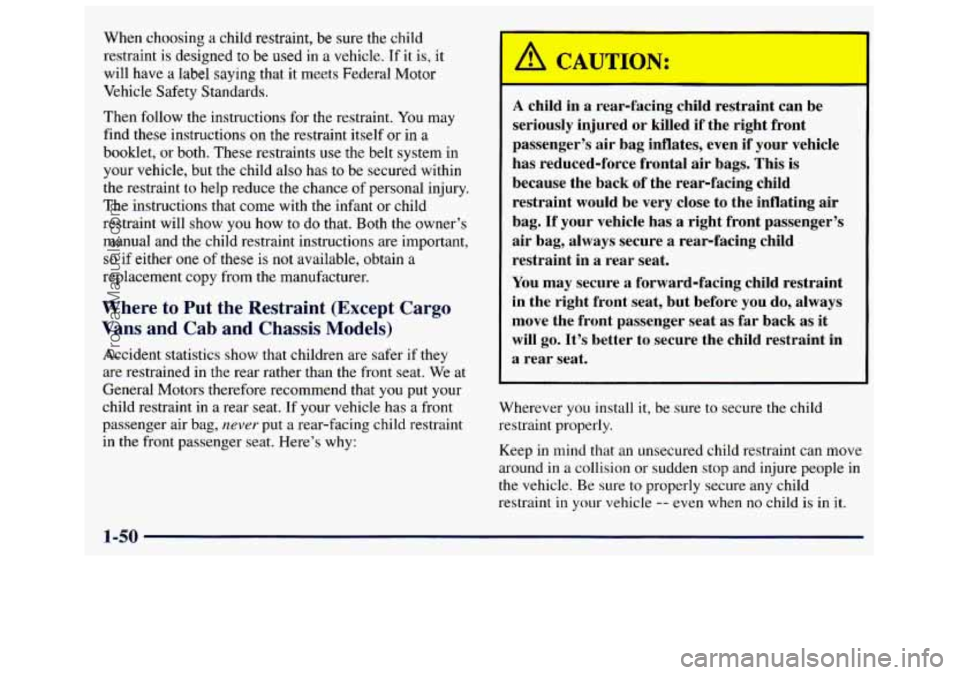
w nen cnoosing a child restraint, be sure the child
restraint is designed to be used in a vehicle.
If it is, it
will have a label saying that it meets Federal Motor
Vehicle Safety Standards.
Then follow the instructions for the restraint.
You may
find these instructions on the restraint itself or in a
booklet, or both. These restraints use the belt system in
your vehicle, but the child also has to
be secured within
the restraint to help reduce the chance of personal injury.
The instructions that come with the infant or child
restraint will show you how to
do that. Both the owner’s
manual and the child restraint instructions are important,
so if either one of these is not available, obtain a
replacement copy from
the manufacturer.
Where to Put the Restraint (Except Cargo
Vans and Cab and Chassis Models)
Accident statistics show that children are safer if they
are restrained
in the rear rather than the front seat. We at
General Motors therefore recommend that you put your
child restraint in
a rear seat. If your vehicle has a front
passenger air bag,
never put a rear-facing child restraint
in the front passenger seat. Here’s why:
A child in a rear-facing child restraint can be
seriously injured or killed
if the right front
passenger’s air bag inflates, even if your vehicle
has reduced-force frontal air bags. This
is
because the back of the rear-facing child
restraint would be very close to the inflating
air
bag. If your vehicle has a right front passenger’s
air bag, always secure a rear-facing child
restraint in a rear seat.
You may secure
a forward-facing child restraint
in the right front seat, but before
you do, always
move the front passenger seat
as far back as it
will
go. It’s better to secure the child restraint in
a rear seat.
Wherever
you install it, be sure to secure the child
restraint properly.
Keep in mind that an unsecured child restraint can move
around
in a collision or sudden stop and injure people in
the vehicle. Be sure to properly secure any child
restraint
in your vehicle -- even when no child is in it.
1-50
ProCarManuals.com
Page 59 of 388
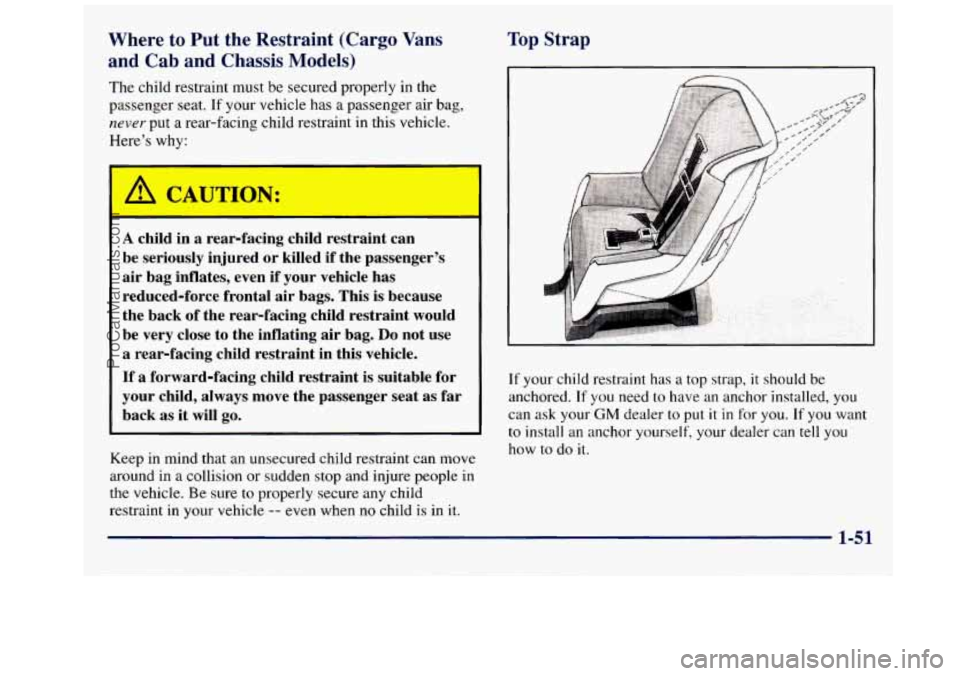
Where to Put the Restraint (Cargo Vans
and Cab and Chassis Models)
The child restraint must be secured properly in the
passenger seat. If your vehicle has a passenger air bag,
never put a rear-facing child restraint in this vehicle.
Here’s why:
A child in a rear-facing child restraint can
be seriously injured or killed
if the passenger’s
air bag inflates, even if your vehicle has
reduced-force frontal air bags. This is because
the back of the rear-facing child restraint would
be very close to the inflating
air bag. Do not use
a rear-facing child restraint
in this vehicle.
If a forward-facing child restraint is suitable for
your child, always move the passenger seat
as far
back as it will go.
Keep in mind that an unsecured child restraint can move
around in
a collision or sudden stop and injure people in
the vehicle. Be sure to properly secure any child
restraint in your vehicle
-- even when no child is in it.
Top Strap
If your child restraint has a top strap, it should be
anchored. If you need to have an anchor installed, you
can ask your GM dealer to put it in for you. If you want
to install an anchor yourself, your dealer can tell you
how to do
it.
1-51
ProCarManuals.com
Page 60 of 388
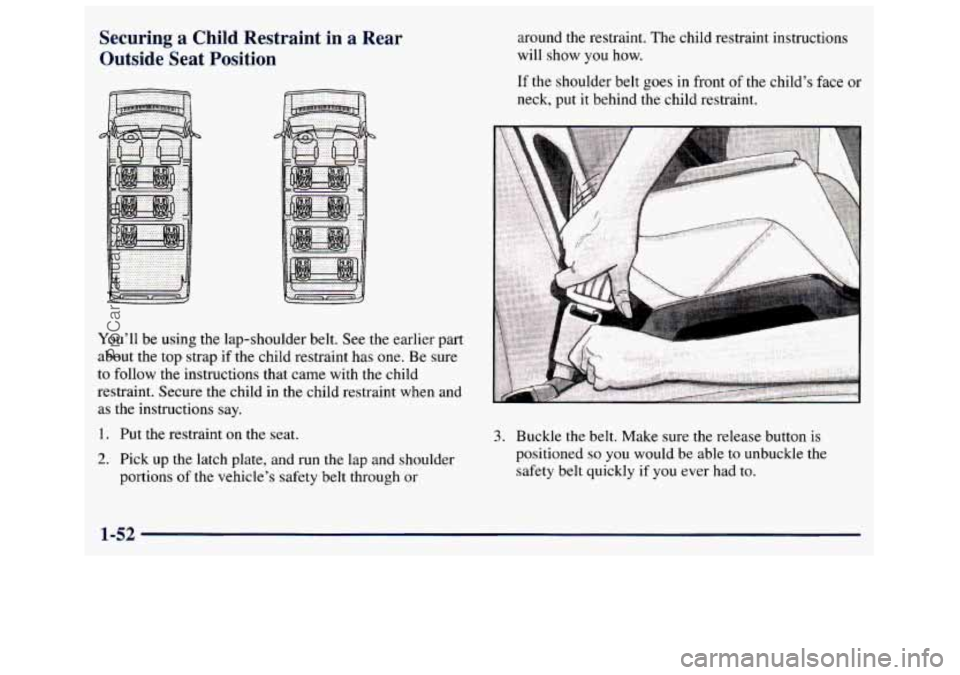
Securing a Child Restraint in a Rear
Outside Seat Position around the restraint. The child restraint instructions
will show
you how.
You’ll be using the lap-shoulder belt. See the earlier part
about the top strap if the child restraint has one. Be sure
to
follow the instructions that came with the child
restraint. Secure the child
in the child restraint when and
as the instructions
say.
1. Put the restraint on the seat.
2. Pick up the latch plate, and run the lap and shoulder
portions of the vehicle’s safety belt through or
If the shoulder belt goes in front of the child’s face or
neck, put
it behind the child restraint.
I
3. Buckle the belt. Make sure the release button is
positioned
so you would be able to unbuckle the
safety belt quickly if
you ever had to.
1-52
ProCarManuals.com
Page 62 of 388
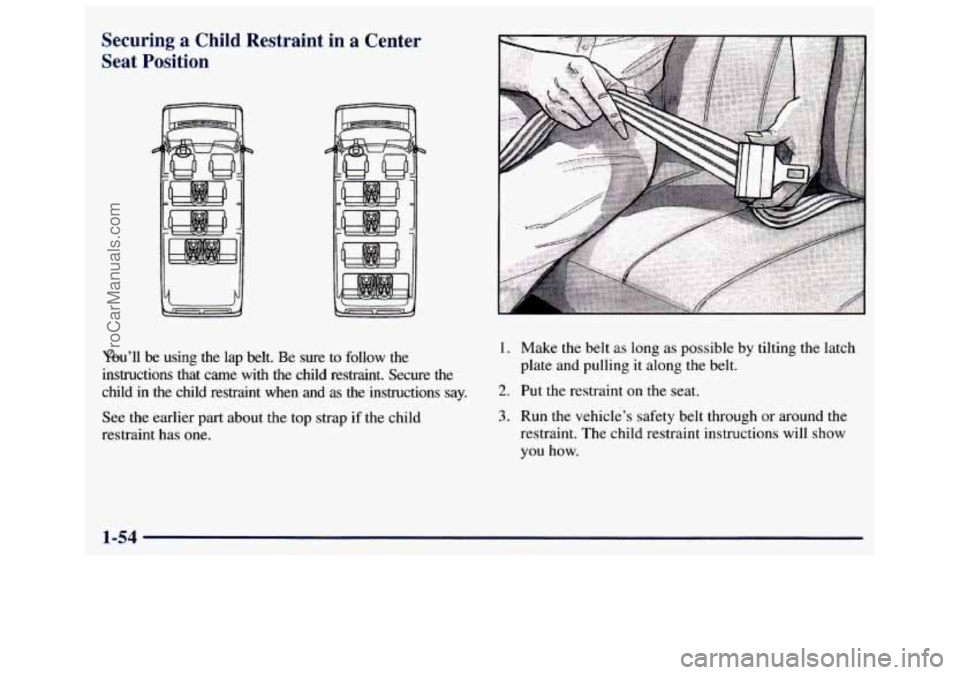
Securing a Child Restraint in a Center
Seat Position
You’ll be using the lap belt. Be sure to follow the
instructions that came with the child restraint. Secure the
child
in the child restraint when and as the instructions say.
See the earlier part about the top strap
if the child
restraint has
one.
1. Make the belt as long as possible by tilting the latch
plate and pulling it along the belt.
2. Put the restraint on the seat.
3. Run the vehicle’s safety belt through or around the
restraint. The child restraint instructions will show
you how.
1-54
ProCarManuals.com